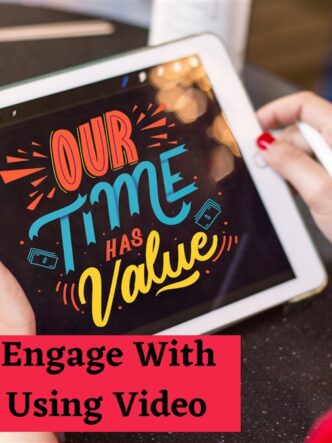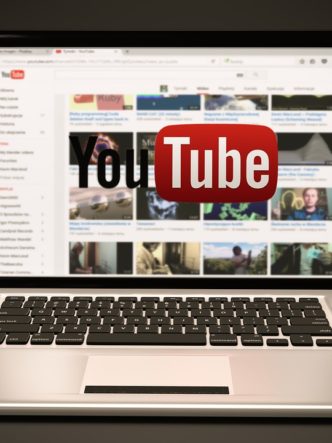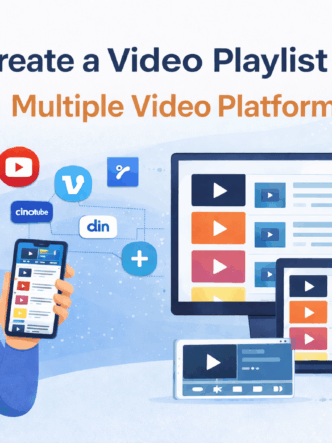What grabs your attention the most when you’re scrolling through social media or browsing a website? Is it a compelling image, a catchy headline, or perhaps a video?
According to statistics, videos get 12 times more shares than images and text combined. There’s solid science behind why videos are such attention-grabbers—it all boils down to human psychology. The challenge for marketers is how to tap into these consumer emotions and the mind to craft something they don’t just see but also prompts them to act.
So, how do we create videos that truly engage and captivate? Stick around as we explore the psychology of video content and uncover strategies to improve video content creation.
What Is Video Content?
Video content is any form of content that uses moving images to convey a message, tell a story, or provide information.
Here are some types of video content:
- Short-form social media videos: These include TikTok clips, Instagram Reels, and Snapchat stories, often used to grab quick attention, entertain, or share bite-sized pieces of information. This online content is perfect for audiences with shorter attention spans or those scrolling through social media feeds looking for quick entertainment.
- Explainer videos: These are frequently used by businesses and educational platforms aiming to break down complex concepts into easy-to-understand pieces. They’re often animated and can be found on websites, product pages, or as part of online courses.
- Tutorial and how-to videos: From cooking recipes and DIY projects to product demos and tutorials used in SaaS marketing, video guides are instrumental in showing viewers how things work.
- Webinars and live streams: These formats are used for workshops, lectures, product launches, and more, allowing for interactive elements like Q&A sessions.
- Product reviews and demos: These videos showcase the features and benefits of a product. They are often used by companies to persuade potential customers or by influencers and reviewers to provide unbiased opinions.
- Vlogs: These are video blogs that document an individual’s life, thoughts, or experiences, offering a personal connection with viewers.
- Brand content: They are crafted to convey a brand’s values, mission, or the stories behind its products and services, aiming to build social proof.
Each type of video content serves a crucial role in marketing. However, of all these, product videos are the most popular, with 63% of marketers incorporating them into their strategy.
This doesn’t necessarily mean you yourself should leverage product videos to boost audience engagement. The data above, after all, might not necessarily apply to you.
To determine with accuracy what the best type of video to produce as part of your promotional tactics, use tools that give you valuable insights into your audience’s content consumption and customer behaviors.
For instance, Google’s shift to GA4 has made it easy for marketers to glean even more detailed video marketing insights. With GA4’s event-based tracking, you can monitor specific video interactions such as plays, pauses, and completions, apart from the usual metrics like views, watch time, and engagement rate.
Social media platforms also have in-built features that allow you to see which of your video content pieces garnered the most likes, comments, and shares.
Based on the data you gather from these tools, you can make informed decisions about the specific types of video content to double-down on for the best results.
Relationship Between Video and Emotions
Videos can make you laugh, cry, or feel inspired. They can stir lingering emotional responses that prompt humans to act. But what makes videos so effective in connecting with us? Here are some concepts worth discussing:
Visual Processing Efficiency
Humans are visual creatures. Our brains are wired to process visual information far more efficiently than text, in fact, 60,000 times faster.
One advantage of this efficiency is the reduction of cognitive load. Videos that combine visuals with audio provide a dual-coding pathway. That means they prompt viewers to use both the visual and auditory channels of the brain during the process of content consumption. This allows for a more engaging and less mentally taxing experience, ultimately resulting in better message comprehension.
Retention
One of the strengths of video content is its remarkable ability to boost information retention. Research shows that people remember 95% of a message when it’s watched compared to 10% when read.
So, when viewers watch a video, they’re not just passively consuming the information that influences their emotions. They’re engaging with the content in a way that makes this video information–and therefore, the associated emotions—stick.
5 Ways to Improve Your Videos Using Psychology
Understanding the psychology of video content is crucial for creating attention-grabbing videos. With that in mind, here are five ways you can improve your video content using psychology:
1. Use Color to Get Message Across
Have you ever wondered why stop signs are made red? Or why cautionary warnings are often painted in bold yellow? It’s simple—red commands urgency and demands attention, while yellow signifies caution and prompts us to proceed with care.
Humans have the tendency to associate colors with specific emotions. In fact, a cross-cultural study involving over 4000 people from 30 countries found that these consumer perceptions were, by and large, universal. In the study, the majority of the respondents associated pink with love and black with sadness, for example.
You can leverage color psychology to get your viewers to feel certain emotions while they consume your video. This way, you can easily get the right message across, and, ultimately, get your viewers to take your desired action.
Assume you’re showing a promotional video of your latest product. Why not use vibrant red colors that will help convey a sense of urgency? This may prompt viewers to click on the Buy button right after they watch.
If you’re promoting services that aim to relax (maybe you’re a yoga instructor), then you might want yoga-related video content that makes your viewers calm. Your goal could be to give them an idea of how they’d feel if they avail of your services.
Then, in this case, you should infuse your video content with soft, muted tones that serve as emotional triggers of tranquility and relaxation. With the relaxing experience you provide with your inspirational content, you may easily persuade your viewers that your services are worth it.
2. Leverage Music to Evoke Emotions
You know that feeling when a catchy song comes on and suddenly you feel happy? There’s a scientific explanation for this: This type of music triggers dopamine in your brain. Dopamine is like your brain’s reward system. Higher levels of dopamine results in feelings of pleasure and satisfaction.
Now what happens if you hear sad songs instead? You feel calm and nostalgic, don’t you? That’s because your brain doesn’t just release dopamine when this happens, but also prolactin. High levels of prolactin are associated with feelings of relaxation.
Take advantage of these scientific and psychological processes to make your viewers feel the way you want them to when they’re watching your online video content. The right music can set the tone and mood for your message, ensuring you communicate it the right way.
So, if you’re looking to boost energy and excitement, choose a track with a catchy rhythm and lively melody. But if you want a nostalgic emotional experience, go for a soulful ballad or a poignant instrumental piece.
3. Employ Storytelling to Engage Audiences
You’ve probably come across countless articles and experts telling you to avoid the salesy approach in your marketing strategy and focus on storytelling. But what makes storytelling so effective?
It’s the emotional impact it creates.
Humans are hardwired to respond to stories. When we hear a well-told story, we become emotionally invested in the characters, the plot, and the outcome. Emotional videos not only capture the attention of consumers but also make the message more relatable and memorable.
And when applied to your marketing efforts, storytelling becomes a powerful tool for engagement. For instance, if you’re promoting products, instead of bombarding potential business customers with a direct sales pitch, why not show them some social proof?
You can share video testimonials of people whose lives have been transformed by your product or how people incorporate it into their routines. This way, you demonstrate the value of what you’re offering in a way that feels authentic and relatable.
4. Engage Viewers with Short-Form Content
Did you know that the average person will only consume a video if it’s less than 60 seconds long? Yes, that’s how short human attention spans are now.
Now, what does this mean for you as a content creator? Well, the shorter your video, the better. That just means the more chances of it being consumed in its entirety. Marketers know this. In fact, almost one-third of marketing professionals surveyed by Hubspot say they’ll leverage short-form videos in 2024. Over 50% even said they’d increase their investment in this type of video content in the same year.
If you have a hard time condensing everything you want to say into a few paragraphs, you can use generative AI to help you create a short script. Just insert the right prompts, and the tool will produce a video script that follows your guidelines.
5. Include Data
The backbone of any successful video lies in its content. Well-researched content not only adds value to your video but also establishes your credibility as an authority in your field.
Psychology can explain why humans love data, specifically numbers. According to Swiss psychologist Carl Jung, numbers are “archetypes,” or instinctual patterns of mankind’s behavior. For humans, they help bring order into an otherwise chaotic appearance.
What does this mean for you? It simply means that if you want your videos to resonate with your target audience, incorporate figures as much as possible. If you’re promoting your next annual event with your video content, why not mention how many people attended last year’s event? That’s a great way to leverage social proof, too.
Or, if your video aims to teach people how to use your product, you can mention how many features it has that can help them perform a specific task.
There are many ways you can incorporate numbers into your video content to make it subconsciously appealing to viewers. Just make sure your numbers are accurate and are backed by credible sources.
Don’t overdo it either. You might just fail at getting your main message across if you focus too much on incorporating numbers into your videos just to make them attractive.
Conclusion
At a time when attention spans are dropping, and competition for the attention of consumers is increasing, it’s more important than ever to create content that immediately captures audience interest.
Video marketing has emerged as a powerful tool for capturing attention. However, if you want your content to be truly effective, don’t just use video to convey information. Leverage psychology to influence consumer behavior with your content as well.
By using the psychology of video content to your advantage, you can create engaging and impactful pieces that prompt your audience to act. Ultimately, you’ll reach, not just your marketing goals, but your business goals as well.
Author Bio
David Pagotto is the Founder and Managing Director of SIXGUN, a digital marketing agency based in Melbourne. He has been involved in digital marketing for over 10 years, helping organizations get more customers, more reach, and more impact.









